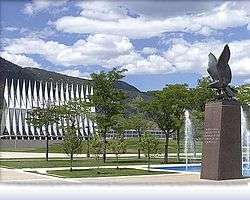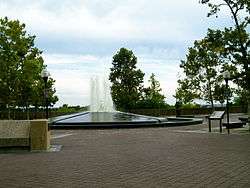Dan Kiley



Daniel Urban Kiley (2 September 1912 – 21 February 2004) was an American landscape architect in the modernist style.[1] He designed more than 1,000 projects including the Jefferson National Expansion Memorial in St. Louis and the Art Institute of Chicago's South Garden.[2]
Life and career
Kiley was born in Boston, Massachusetts. In 1932, he began a four-year apprenticeship with landscape architect Warren Manning, during which he learned the fundamentals of office practice and developed an interest in the role of plants in design, sparking his later creative and innovative use of plants in the landscape. In 1936, Kiley entered the design program at Harvard University, while continuing work with Manning. Among his classmates and friends were Garrett Eckbo and James C. Rose, who also became influential landscape architects. After two years at Harvard, Kiley left without graduating. He worked briefly for the National Park Service in Concord, New Hampshire, and later the United States Housing Authority, where he met architect Louis Kahn. On Kahn’s advice, Kiley left the Housing Authority in 1940 to become a licensed practitioner of architecture.
From 1943 to 1945, Kiley served in the U.S. Army. At the end of World War II, Kiley designed the courtroom where the Nuremberg Trials were held. In Europe, he visited the work of André Le Nôtre at Sceaux Chantilly, Versailles, and Vaux-le-Vicomte, whose formality and geometric layout shaped his future Classical Modernist style.
Following the war, Kiley found himself one of the only modern landscape architects in the postwar building boom. In California, his friend Garrett Eckbo, Thomas Church and others were developing and practicing the modernist style. Kiley returned to his practice in New Hampshire, and later moved it to Vermont. In collaboration with modern architect Eero Saarinen, Kiley entered and won the competition to design for the Jefferson National Expansion Memorial, a high-profile job that launched his career as a landscape architect.
Kiley’s first essentially modern landscape design was the Miller Garden in 1955, which is now owned by the Indianapolis Museum of Art and known as the Miller House and Garden. Among his other masterworks are the Fountain Place in Dallas, Texas; the NationsBank Plaza in Tampa, Florida; the United States Air Force Academy; the Oakland Museum; Independence Mall in Philadelphia; and the Dallas Museum of Art. He completed more than 900 projects, which received countless awards. In 1997, he was presented with the National Medal of Arts. In his office, he hired and inspired designers such as Richard Haag, Peter Hornbeck, Peter Ker Walker, Peter Schaudt and Ian Tyndal.
The unique geometric layout of allees, bosques, water, paths, orchards, and lawns characterize Dan Kiley’s design. To Kiley, regular geometry lay at the heart of his design. Like his predecessors, Le Corbusier and Le Nôtre, Kiley believed that geometry was an inherent part of man. It was the structure man could use to gain comprehension and create stabilization of his surroundings. He also firmly believed that man was a part of nature, rather than being separate from it. Rather than copying and trying to imitate the curvilinear forms of nature he asserted mathematical order to the landscape. Kiley’s landscapes overstepped their boundaries rather than ending elements neatly on a suggested edge. He called this approach, slippage, or an extension beyond the implied boundary, creating ambiguous relationships in the landscape. Dan Kiley was a landscape architect made famous by his hundreds of distinguished works of landscape design, and inspires many students and professionals in the field of landscape architecture.
Exhibitions
In 2013, The Cultural Landscape Foundation (TCLF) organized a traveling, photographic exhibition titled The Landscape Architecture Legacy of Dan Kiley, which features 45 newly commissioned photographs of 27 of Kiley’s more than 1,000 designs. It is currently on a multi-year, national tour.
Awards
- Elected into the National Academy of Design (1963)
- Lifetime Honors – National Medal of Arts (1997)[3]
- Lifetime Achievement – Cooper-Hewitt National Design Museum (2002)[4]
Influential projects
- Miller House and Garden, 1955
- Cathedral of the Immaculate Conception (landscape) - Burlington, Vermont. Completed 1977. Edward Larrabee Barnes, lead architect
- Seymour Krieger House, 1958
- Chicago Botanic Garden
- NationsBank Plaza, 1985
- La Défense, Paris
- Jefferson National Expansion Memorial, St. Louis; Eero Saarinen, architect
- John F. Kennedy Library, Boston
- Lincoln Center, Manhattan
- Fountain Plaza, Dallas, Texas
- United States Air Force Academy, Colorado Springs, Colorado
- National Center for Atmospheric Research (landscape) – Boulder, Colorado. Completed 1967. I. M. Pei, lead architect
- Jardine Water Purification Plant, Chicago, Illinois, 1965
- Cudahy Gardens, Milwaukee, Wisconsin
- Union Terrace, Madison, Wisconsin
- Benjamin Banneker Park, Washington, D.C. Completed in 1970.[5]
- Kiley Garden, downtown Tampa, Florida[2]
- Agnes R. Katz Plaza, Pittsburgh, Pennsylvania[2]
Notes
- ↑ Martin, Douglas (February 25, 2004). "Dan Kiley, Influential Landscape Architect, Dies at 91". New York Times.
- 1 2 3 Byrnes, Mark (May 5, 2014). "Remembering Modernism's Go-To Landscape Architect". CityLab. Atlantic Media.
- ↑ "Lifetime Honors: National Medal of Arts".
- ↑ "Lifetime Achievement Award: Winner Dan Kiley". Cooper-Hewitt National Design Museum. Archived from the original on 2010-09-25.
- ↑ "BENJAMIN BANNEKER PARK, BANNEKER CIRCLE: SOUTHWEST AT L'ENFANT PROMENADE". Most Endangered Places for 2004. D.C. Preservation League. 2007. Archived from the original on 2004-08-24. Retrieved 2011-10-05.
Designed by renowned landscape architect Daniel Urban Kiley ... (the park) is culturally significant as the first public space in Washington named for an African American and is usually included in Black History tours.
References
- "A Designer's Designer, Dan Kiley Cast a Long Shadow, Appreciations by his Associates and Friends". Landscape Architecture. 94 (5): 116–125. May 2004.
- "Dan Kiley: Biographical Information". Garden Visits.com.
- Oppenheimer, Andrea (February 1996). "Modern Master". Landscape Architecture. 86 (2): 74–79.
- Treib, Marc (2005). "Dan Kiley and Classical Modernism: Mies in Leaf" (PDF). Landscape Journal. 24 (1): 1–12.
- Walker, Peter (August 3, 2005). "Biography of Dan Kiley". The Cultural Landscape Foundation.